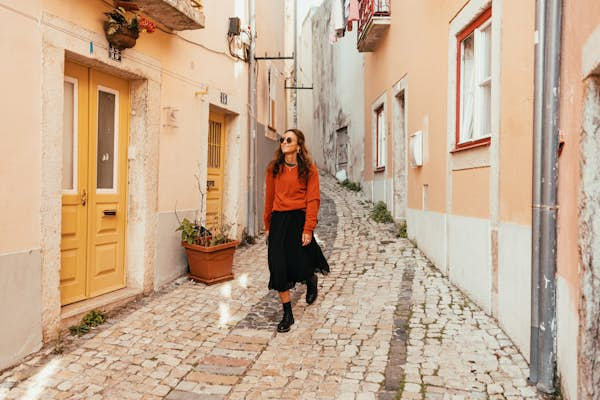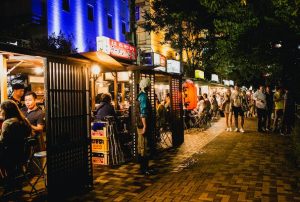
My trip to Lisbon was nearly six years ago, but I can still feel it in my body. I love the way that new places get under your skin and become part of your DNA, not just your memory or your camera roll. I couldn’t get over the food, the architecture, the history, the culture – it made me literally break out into song.
I’ll explain. Our evening began innocently enough: sunset views and drinking cocktails at Park in Bairro Alto, followed by dinner and wine at Taberna da Rua das Flores and a nightcap at a burlesque club. Then it seemed that we should call it a night, so we wandered back to our hotel. As we ambled, we came across a stage that had been set up outside Lisbon City Hall, so naturally, we climbed up and began singing a random mash-up of old show tunes.
Immerse yourself in the best experiences the world has to offer with our email newsletter delivered weekly into your inbox.
I can’t tell you why we did that – maybe the burlesque? All I know is Lisbon made me need to sing out loud, and celebrate being alive (#Sondheim) and (relatively) young and being in a magical, new (to me) place.
This is why we travel, no? I spoke with Tiago Filipe, a guide who works with Elsewhere (a Lonely Planet company) crafting custom itineraries for travelers who want the inside track on the best things to do, see, and, perhaps most importantly, eat in Lisboa. We discussed everything he loves about his home city (and country). Take note of his expert food-and-drink recommendations at the end!
 Let Tiago curate your ideal Lisbon itinerary © Lonely Planet
Let Tiago curate your ideal Lisbon itinerary © Lonely Planet
Q&A with Elsewhere’s Tiago Filipe
The passion and pride that Tiago Filipe feels for his home is palpable – just talking to him for an hour had me cruising Google Flights and getting tips for my next trip to Portugal.
Where are you from?
I was born and raised in Lisbon. I’ve lived here most of my life.
What made you want to become a guide?
My father was a historian, and we traveled extensively around the country, so I got to know a lot about Portugal. After traveling and traveling, living in Liverpool and Mozambique, the people I’d met along the way started to visit me in Lisbon. So that’s how it began: it was a hobby and grew into a career. Being a proud Portuguese also helps.
What is so special about Lisbon?
I love it. It’s a very beautiful city, but it’s not only that. It’s such a diverse place: the geography, the weather, the beaches. You can be on the coast or in the mountains within 30 minutes. When summer days are longer, I can stop working at six or seven and still have time to go surfing for a couple of hours. I think that’s priceless – it’s truly incredible.
What dishes best define Portuguese cuisine?
That’s a very difficult question. I could give you 30 dishes, and there would still be more. It’s such a small country and yet has an incredibly diverse cuisine – it’s stunning. Some chefs say Portugal has the best fish in the world. We are now in June, the main month of festivities in Portugal.
Grilled sardines are the highlight during this time. We have a number of different seafood stews, like caldeirada, cataplana, massada de peixe, and Açorda de Marisco. And our custard tart – pastel de Belém – is very famous, everyone loves it. It’s probably one of my favorite pastries.
 Oceanário is one of the most popular attractions in Lisbon © Merrill Images / Getty Images
Oceanário is one of the most popular attractions in Lisbon © Merrill Images / Getty Images
What are some fun sites to see in Lisbon?
In Belém, visit Jerónimos Monastery. The Old Expo 98 area has all these different thematic gardens, the Ciência Viva (Living Science) Center, the cable car. But the highlight is without a doubt the mind-blowing aquarium, Oceanário. And just walking in Alfama – the narrow and hilly streets and the ambiance of the place.
Is there a day trip or experience near Lisbon you’d recommend?
Visiting the palaces of Sintra. Specifically, Quinta da Regaleira, an estate and palace developed by a Portuguese aristocrat in the 1800s with mystic gardens, a famous spiral well, caves, lakes and tunnels. The Monserrate palace also boasts gorgeous gardens and beautiful architecture, and it’s much less crowded.
When is the best time to visit?
My favorite time of year is October. I also like May – the transition months.
Where do you recommend people stay?
As a guide, I prefer people to stay in hotels because it’s easier for me to control what they’re going to get. Hotels tend to be a bit more hassle-free than Airbnb. I like the Porto Bay properties and the collection of Lisbon Heritage Hotels.
 Just because Lisbon’s yellow trams are touristy, doesn’t mean you should miss them © RossHelen / Shutterstock
Just because Lisbon’s yellow trams are touristy, doesn’t mean you should miss them © RossHelen / Shutterstock
Is there a super touristy thing that one should do?
Get on the yellow tram. It’s a landmark and a highlight of the city. Take it to a high point and walk down, it’s a great way to see the old city.
The best places to eat and drink in Lisbon
To be in Portugal is to eat. And eat a lot. Here are a few of Tiago’s favorite local spots in Lisbon, and one incredible dish you must travel to the Azores to try.
1. Book an authentic Portuguese restaurant. I like Pinóquio and Rosa da Rua. Both are central and have very Portuguese menus. I also recommend Salsa & Coentros, Dom Feijão, and Ramiro is a classic.
2. Poke around Carnide There are some really good restaurants in this less-trafficked Lisbon neighborhood, including Paço de Carnide and Adega das Gravatas.
3. Listen to live fado. The calm, soft instrumental music is longing and sorrowful.Tasca Bela in Alfama is an old favorite for live fado – and the food is good.
4. Have drinks at Pavilhão Chinês. Not far from Bairro Alto, this bar is in a historic building and decorated like an old curiosity shop. It’s really unusual.
5. Have a meal with ocean views. Enjoying Portugal’s signature seafood dishes is best done by the water at Furnas do Guincho in Cascais or in Sintra at Azenhas do Mar.
6. Go to the Azores for cozido das Furnas. They prepare this meat stew in a pan that is buried underground and naturally heated in the volcanic soil.



